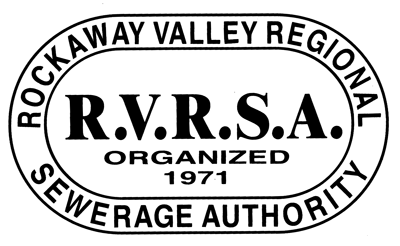Facility Overview
The origin of Rockaway Valley Regional Sewerage Authority (RVRSA) and wastewater treatment in this area dates back over a century. In approximately 1900, the city of Jersey City acquired the Rockaway River water supply system, including the Boonton Reservoir, from private development interests. It wasn’t until pollution problems began to arise within the Rockaway River water supply system that Jersey City constructed a sewage treatment plant and interceptor sewer (in the early 1920’s).
Residential and industrial development in the Rockaway River watershed exploded during the 1940’s and 1950’s, and by the mid-1960’s, the Jersey City treatment plant could not treat the wastes properly – allowing the pollution of the Rockaway River due to untreated sewage. In 1968 the Superior Court of New Jersey ordered Jersey City to construct a new facility due to the contamination and pollution of the Rockaway River. Due to this lawsuit brought against Jersey City, the Rockaway Valley Regional Sewerage Authority was formed, in 1972. Rockaway Valley Regional Sewerage Authority services nine (9) towns (Town of Boonton, Township of Boonton, Township of Denville, Borough of Rockaway, Township of Rockaway, Town of Dover, Township of Randolph, Victory Gardens and Borough of Wharton), one customer (Mine Hill) and one federal facility (Picatinny Arsenal).
Rockaway Valley Regional Sewerage Authority’s next major change was in the late 1970’s/early 1980’s. At this time, RVRSA received federal grant money to upgrade the facility to a 12 million gallon a day (MGD) plant, at an initial cost of $32 million. The new 12 MGD plant went on-line in September 1985 and today is the current operating facility.
THE TREATMENT PROCESS
Rockaway Valley Regional Sewerage Authority treats a variety of wastes from households, commercial and industrial facilities. These wastes are considered sanitary and industrial wastes. Storm water runoff from streets, land and roofs of buildings are collected separately in storm sewers. RVRSA does not accept storm water. Storm water runoff is sent directly into the rivers and streams via a separate storm water collection system located within each municipality and industrial sites.
Sanitary wastewater flows through a series of sewer lines, chambers and pumping stations, which collectively is called a “collection system”. Each member town and customer of RVRSA maintain their own collection system. These sewer lines then flow into the RVRSA main “trunk”, which then flows, via gravity, to the RVRSA treatment plant. In 2011, Hurricane Irene caused a portion of the RVRSA trunk line, that crossed the Rockaway River, to wash away. To replace this section of pipeline, the RVRSA has designed two pump stations, both in the Town of Boonton, and expects to begin construction in late spring of 2015.
RVRSA’s level of treatment is “secondary” and is designed to treat 12 million gallons per day of wastewater. Currently RVRSA successfully treats an average of 9 – 10 million gallons per day.
The influent flow enters the RVRSA treatment plant at the Preliminary Treatment building where screening, grit removal and pre-aeration occur. Next the wastestream enters Division Box A where the waste is combined with return activated sludge and is then equally distributed to two large oxidation channels (2.75 mgd – each channel; 330’ (long) X 100’ (wide) X 12’ (side) water depth) where secondary treatment, Nitrification (oxidation of ammonia to nitrates) and BOD (biochemical oxygen demand) removal occurs. In 2007, the RVRSA modified it’s operation to utilize the oxidation channels to also biologically reduce phosphorus and denitrify (oxidize nitrates to nitrogen gas) to further reduce nitrogen (nitrates) in the wastestream. Within the oxidation channels, microorganisms break down organic matter, and use as a food source, thereby cleaning the wastewater. The wastewater stream then flows to division Box B, and is equally distributed to the final clarifiers. In the Final Clarifiers activated sludge (microorganisms) is separated from the clean water. The activated sludge settles to the bottom of the clarifiers via gravity. A portion of the settled sludge is then pumped to the Sludge Processing Building for dewatering and thickening. The final de-watered sludge is then trucked to Passaic Valley Sewerage Commission, in Newark, New Jersey, for further treatment and ultimate disposal. The balance of the settled sludge (return activated sludge) is pumped to Box A to mix with the Plant Influent and distributed back into the Oxidation Channels to begin the process again.
The final step in the RVRSA treatment process is disinfection (or chlorination) and de-chlorination. RVRSA’s chlorination and de-chlorination is by chemical addition (chlorination – sodium hypochlorite; de-chlorination – sodium bi-sulfate). The “de-chlorinated” and “treated” wastewater (effluent) then flows into the Rockaway River.
The final effluent from the RVRSA facility is sampled and tested daily to insure RVRSA is meeting and complying with its New Jersey Pollutant Discharge Elimination System (NJPDES) permit.
